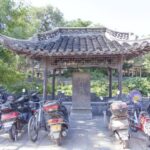Quzhou Confucius Temple, commonly known as the Southern Ancestral Hall, has a history of over 700 years. At the end of the Northern Song Dynasty, as the Jurchens invaded the south, Emperor Gaozong Zhao Gou hastily moved southward and established his capital in Lin’an. The 48th descendant of Confucius, Kong Duanyou, carried the wooden statues of Confucius and his wife, leaving Qufu in Shandong and relocating here. Later, the Confucian family temple was built by imperial order, serving as the ancestral temple.
Modeled after the Confucius Temple in Qufu, Shandong, the Quzhou Confucius Temple is also divided into two parts: the Confucian mansion and the temple. The temple is surrounded by towering ancient trees and grand palaces. The ‘Portrait of the Sage’ stele in front of the Silu Pavilion is said to be painted by Tang Dynasty artist Wu Daozi and is extremely precious. The entire ancient architectural complex is solemn and heavy with a rich atmosphere of Confucian culture. The Sage’s Wooden Statue: After Confucius’s death, to express gratitude to their teacher, his disciples built huts in front of his tomb and mourned for three years, with Zigong alone staying an additional three years. During this time, Zigong carved a pair of statues for his teacher and teacher’s wife from the Kai trees in the Confucian forest, later known as the ‘Kai Wooden Statues’. At the beginning of the Southern Song Dynasty, Kong Duanyou led his clan southward with the family treasure, the ‘Kai Wooden Statues’. During the Qing Qianlong period, Feng Shike recorded the story of ‘Protecting the Sage’s Statue’, which tells of how Kong Duanyou, carrying the wooden statue, arrived in the south and, after his boat capsized in Zhenjiang, three divine figures emerged from the waves and retrieved the statue. The smoke from his incense offerings spelled out the words ‘Deity of Lu and Fu Mountain’. Kong Duanyou then resided in Quzhou with the sacred statue. Later, ‘Deity of Lu and Fu Mountain Temples’ were built at the four corners of the city to pray for divine favor. The statue has been treasured by the Southern Ancestral Hall of the Kong family and protected by generations with great care. During the Japanese invasion of Quzhou, to prevent looting, Kong Fanhao, following an order from the Nanjing government, escorted the sacred statue to the Longquan and Qingyuan mountain areas. In 1946, the Kai Wooden Statue was returned to the temple and treasured in the ‘Silu Pavilion’ of the family temple. The temple is open all year round from 09:00 to 17:00, with specific business hours subject to the daily opening status. Preferential policies include free admission for children and the elderly over 70 years old, and for children under 18. Elderly people aged 60 to 70 can purchase tickets at a half-price from the manual window. Students with a student ID can also purchase tickets at a half-price from the manual window.Quzhou Confucius Temple, the Southern Ancestral Hall
Quzhou Confucius Temple, commonly known as the Southern Ancestral Hall, has a history of over 700 ye[...]









